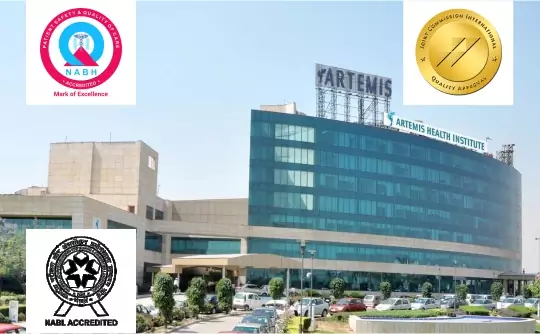

Uterine Artery Embolization Cost in India starts from US $2,900 and varies depending on the approach, your medical history, surgeon, facility and the city where you choose to get the surgery done.
An important expense when it comes to your Uterine Artery Embolization is going to be your Doctor's fees. IndiCure recommends experienced, skilled, board-certified surgeons who are capable of delivering successful surgeries. The charges may vary depending on the experience of the surgeon, popularity, and the approach to treatment.
A significant portion of the overall cost of the surgery arises from the use of any customized surgical instruments or specialized technology. With the hopes of improving patient care, new techniques and technologies are often introduced to the surgical process. Such innovative advancements in the surgical approach can increase costs.
Having your Uterine Artery Embolization in an accredited surgical facility by skilled and qualified medical staff is a critical factor. Moreover, the geographical location of this facility also affects the initial quote. But, IndiCure provides you with a projected estimate that will be affordable.
The surgery-related expenses include the pre- and post-surgical expenses. The pre-surgical expenses are associated with the candidacy and the medical history of the patient. This also includes the routine medical exams and tests to ensure you're a good fit for the surgery. Post-surgical expenses may include prescription medications and follow-up consultations.
We at IndiCure, understand that you travel with a budget in mind and do not like to be greeted by surprises after arrival in India. We thus club all these expenses and give you the package cost that is inclusive and affordable at the same time.
Your case manager shall give you an estimated cost of your surgery after discussing your medical reports with the surgeon. The final cost, however, shall be confirmed after your consultation with the surgeon.
In fact, we have Special Negotiated Rates with the Hospitals and you can avail Discounted Rates when you choose to Travel with IndiCure.


We Help you Choose the Right Treatment, Surgeon & Hospital

We Arrange Video/Telephonic Consultation with the Surgeon

We Assist you with Visa & Accommodation

We Receive you at the Airport and Drop you at Hotel/Hospital

We Assist you the at Hospital & Provide Post Operative Support
Years of Experience
Happy Clients
Countries Patient Treated
Most Affordable Price

Gurgaon
Fortis Memorial Research Institute (FMRI), the flagship hospital of Fortis Healthcare, is a multi-specialty, quaternary care hospital and is counted among the best hospitals in India and the world. The hospital is considered as "Mecca of Healthcare" and a referral hospital, not only in the entire Asia Pacific but much beyond.

Gurgaon
Artemis Health Institute, a premium multi-specialty hospital is a healthcare venture launched by the promoters of the Apollo Tyres Group. Established in 2007, Artemis was the first hospital in Haryana to get NABH accreditation within 3 years of start-up.
Uterine Artery Embolization (UAE) is a minimally invasive treatment used to stop serious pelvic bleeding. The most common reason for performing Uterine Artery Embolization is Uterine fibroids (non-cancerous tumors inside the uterus). Other conditions include trauma, malignant (cancerous) gynecological tumors, or hemorrhage after childbirth, among other things.
Uterine artery embolization (UAE) is a procedure that involves blocking the flow of blood to the uterus and thus helps women who have severe pelvic bleeding as a result of fibroids or other disorders.
The most common cause for uterine fibroid embolization is to treat uterine fibroid tumors that are causing discomfort or other complications.
Your doctor may recommend this procedure if you have:
Uterine fibroid embolization (UFE) should not be done for the following reasons:
An interventional radiologist performs the UAE in a catheterization lab or operating room and normally takes about 90 minutes to complete the process.
The patient is placed on an examination table and connected to machines that will monitor vital indicators like heart rate, blood pressure, and respiration. An anesthetic (pain reliever) and sedative is administered through an IV (intravenous) line.
A tiny incision is created in the groin region. The insertion and positioning of a catheter is guided by an X-ray camera (fluoroscope) and contrast dyes. The catheter injects embolic substances (such as polyvinyl alcohol) into certain uterine arteries to stop blood flow.
The catheter is withdrawn once the procedure is completed. The incision's bleeding is stopped, and a bandage is applied. No stitches are required. While the patient is in the hospital for observation, pain medicines may be administered.
The majority of patients are able to return home the same day. Painkiller and other drugs are prescribed for usage at home. Within one to two weeks after the surgery, you should be able to resume normal activities.
For a cycle or two, menstrual bleeding may not resume. When it does restart, the amount of blood may be lower than normal, but it will gradually grow over the next few cycles to a level that is better than before the treatment.
In the case of fibroids treatment, symptoms should start to fade in two to three weeks. The rate of improvement reaches a maximum after six months and then stabilizes.
After a year, 90 percent to 92 percent of patients who had uterine artery embolization (UAE) had their bleeding symptoms under control.
Those who got uterine fibroid embolization (UFE) for fibroids therapy reported similar levels of satisfaction at one and five years as patients who received surgical treatment.
We at IndiCure completely understand your concerns and it is always our endeavor to provide the best outcome for every patient. Following is the list of questions you must ask before you embark on your journey for Uterine Artery Embolization in India.
Prepare to answer questions about your:

Uterine fibroid embolization is a technique for shrinking uterine fibroids, which are noncancerous tumors in the uterus. Because it does not require significant surgery, you may be able to recover faster. It's also possible that you won't need to stay in the hospital. Fibroid embolization in the uterus reduces fibroids by cutting off their blood supply.
The level of pain varies from patient to patient. The worst discomfort usually happens right after the surgery and lasts for the next six hours. This pain is described by patients as being similar to menstruation cramps. Some patients are completely pain-free.
Uterine fibroid embolization is a highly effective surgery with an estimated 85 percent success rate. The majority of women who have the treatment have a significant improvement in their symptoms as well as a reduction in the size of their uterine fibroids. After UFE, if menstruation has been heavy, it should recover to a more regular flow.
Embolization of the uterine artery is generally considered safe. Complications are rare. However, do speak with your doctor about any potential risks.
The trial demonstrated that after UAE, it is possible to conceive and carry a pregnancy to term. It also showed that the surgery increased the chance of aberrant placentation, low or extremely low birth weights, and preterm births.
Source- https://www.ncbi.nlm.nih.gov
A postfertility, premenopausal patient with symptomatic uterine fibroids who wants to avoid hysterectomy is a suitable candidate for Uterine Fibroids Embolization. Patients with pedunculated subserosal fibroids are not regarded excellent candidates, despite the fact that there is no predetermined size restriction.
Experts say that you will still get your period following a UFE operation, but your flow will become lighter with each menstruation cycle. You will continue to have your period. In fact, your first period after the operation is highly likely to be really heavy.
When comparing a hysterectomy to Uterine Fibroid Embolization, UFE is less painful, has less dangers, and takes less time to recover. You can go home the same day as your operation with this minimally invasive approach.
In most cases, patients who have cervical, endometrial, or uterine cancer are not candidates for embolization. Besides, women who have a pelvic infection that is active, recent, or persistent or patients suffering from severe peripheral vascular disease, or women who have uncontrollable bleeding are not good candidates for Uterine Fibroids Embolization.
Because fibroid tumors frequently grow back after hormone therapy is stopped, uterine fibroid embolization is a more permanent cure than hormonal therapy.
About 25,000 UAE procedures are performed around the world each year.
Though rare, following are the risks associated with uterine artery embolization:
Within ten days, ninety percent of patients are back to normal. A hysterectomy, on the other hand, can take up to six weeks to recuperate from.
Enhance your medical journey to India by availing these extra services.
Traveling abroad for medical reasons may be challenging. With our experience of over a decade and working with the best surgeons and top hospitals in India, we help make your medical tour easier and safer for you. We will guide you at every step of the way and make end-to-end arrangements for your surgery, travel, and stay.
Ramandeep Dhaliwal
a month ago
I had great experience having rhinoplasty through Indicure. Dr. Ruchika from Indicure has helped me in finding best plastic surgeon, answering all my questions...
Read More
Joshua Archer
3 months ago
My name is Joshua Archer I'm from New Zealand, bay of plenty, kawerau I opted for the bypass surgery in January 2023 but planned it in advance for 28 September found IndiCure...
Read More
Kera Ren
8 months ago
Absolutely loved my experience with IndiCure - from first inquiring to meeting the surgeon pre op to my follow up post op. The surgeon was extremely approachable...
Read More
Andreana Paul
5 months ago
Had a wonderful experience. Visited India for my plastic surgery. From sending mails, airport pickup, comfortable accommodation and, to smooth hospital appointment booking...
Read More
Brandi Luce
5 months ago
I had the privilege of using Indicure's services for a cosmetic procedure that I had wanted for a long time but had always been apprehensive about. Ruchika helped me...
Read More
Jade M
3 years ago
Indicure Health Tours went above and beyond my expectations. They helped me with every aspect of my journey and were professional, kind and caring. I was...
Read More
The content on the website (www.indicure.com) is intended to be general information and is provided only as a service. All photographs on our website of before and after results are examples only, and do not constitute an implied or any other kind of certainty for the result of surgery.
Learn about IndiCure Health Tours' comprehensive editorial policy that strives to deliver trustworthy, helpful, relevant, accurate and people-first content on medical tourism in India.
It is not medical advice and should not be taken as medical advice. It should not be used to diagnose or treat a health condition and is in no way meant to be a substitute for professional medical care. You are advised to see a surgeon in person to assess what surgery may or may not accomplish for you.
It is also important to keep your expectations realistic and to understand that all surgical procedures carry risks and should never be taken lightly.